
Slavery and enslavement are both the state and the condition of being a slave, who is someone forbidden to quit their service for an enslaver, and who is treated by the enslaver as their property. Slavery typically involves the enslaved person being made to perform some form of work while also having their location or residence dictated by the enslaver. Many historical cases of enslavement occurred when the enslaved broke the law, became indebted, or suffered a military defeat; other forms of slavery were instituted along demographic lines such as race. The duration of a person's enslavement might be for life, or for a fixed period of time, after which freedom would be granted. Although most forms of slavery are explicitly involuntary and involve the coercion of the enslaved, there also exists voluntary slavery, entered into by the enslaved to pay a debt or obtain money. In the course of human history, slavery was a typical feature of civilization, legal in most societies, but it is now outlawed in most countries of the world, except as a punishment for a crime.

Debt bondage, also known as debt slavery, bonded labour, or peonage, is the pledge of a person's services as security for the repayment for a debt or other obligation. Where the terms of the repayment are not clearly or reasonably stated, the person who holds the debt has thus some control over the laborer, whose freedom depends on the undefined debt repayment. The services required to repay the debt may be undefined, and the services' duration may be undefined, thus allowing the person supposedly owed the debt to demand services indefinitely. Debt bondage can be passed on from generation to generation.
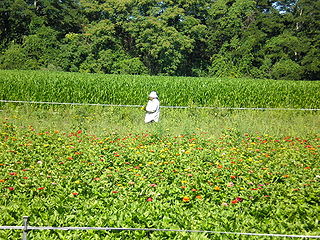
Foreign workers or guest workers are people who work in a country other than one of which they are a citizen. Some foreign workers use a guest worker program in a country with more preferred job prospects than in their home country. Guest workers are often either sent or invited to work outside their home country or have acquired a job before leaving their home country, whereas migrant workers often leave their home country without a specific job in prospect.
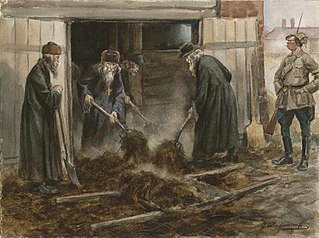
Forced labour, or unfree labour, is any work relation, especially in modern or early modern history, in which people are employed against their will with the threat of destitution, detention, violence including death, or other forms of extreme hardship to either themselves or members of their families.

Child prostitution is prostitution involving a child, and it is a form of commercial sexual exploitation of children. The term normally refers to prostitution of a minor, or person under the legal age of consent. In most jurisdictions, child prostitution is illegal as part of general prohibition on prostitution.
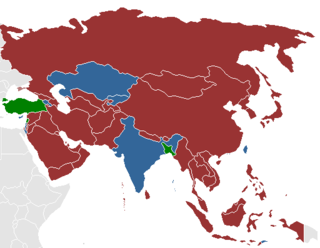
Prostitution is legal in India, but a number of related activities including soliciting, kerb crawling, owning or managing a brothel, prostitution in a hotel, child prostitution, pimping and pandering are illegal. There are, however, many brothels illegally operating in Indian cities including Mumbai, Delhi, Kolkata, Bangalore, and Chennai. UNAIDS estimate there were 657,829 prostitutes in the country as of 2016. Other unofficial estimates have calculated India has roughly 3–10 million prostitutes. India is widely regarded as having one of the world's largest commercial sex industry. It has emerged as a global hub of sex tourism, attracting sex tourists from wealthy countries. The sex industry in India is a multi-billion dollar one, and one of the fastest growing.
Forced prostitution, also known as involuntary prostitution or compulsory prostitution, is prostitution or sexual slavery that takes place as a result of coercion by a third party. The terms "forced prostitution" or "enforced prostitution" appear in international and humanitarian conventions, such as the Rome Statute of the International Criminal Court, but have been inconsistently applied. "Forced prostitution" refers to conditions of control over a person who is coerced by another to engage in sexual activity.

Human trafficking and the prostitution of children is a significant issue in the Philippines, often controlled by organized crime syndicates. Human trafficking is a crime against humanity.

The early history of slavery in India is contested because it depends on the translations of terms such as dasa and dasyu. Greek writer Megasthenes in his work Indika, while describing Mauryan empire states that slavery was banned in Indian society. However, some sources suggest that slavery was likely to have been a widespread institution in ancient India by the lifetime of the Buddha, and perhaps even as far back as the Vedic period.
Prostitution in Kolkata is present in different forms and Kolkata's sex industry is one of the largest in Asia. Prostitution may be brothel-based or non-brothel based as in the case of call girls. India is regarded as having one of the largest commercial sex trades globally. Kolkata has many red-light districts, out of which Sonagachi is the largest red-light district in Asia with more than 50,000 commercial sex workers.
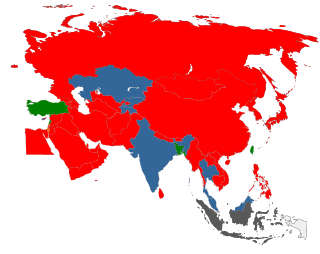
Prostitution in Bangladesh is legal and regulated. Prostitutes must register and state an affidavit stating that they are entering prostitution of their own free choice and that they are unable to find any other work. Bangladeshi prostitutes often suffer poor social conditions and are frequently socially degraded.
Prostitution in Indonesia is legally considered a "crime against decency/morality", although it is widely practiced, tolerated and even regulated in some areas. Some women are financially motivated to become prostitutes, while others may be forced by friends, relatives or strangers. Traditionally, they have met with customers in entertainment venues or special prostitution complexes, or lokalisasi (localization). However, recently internet forums and Facebook have been used to facilitate prostitute-client relations. In recent years, child sex tourism has become an issue at the resort islands of Batam and Bali.

Human trafficking is the trade of humans for the purpose of forced labour, sexual slavery, or commercial sexual exploitation for the trafficker or others. This may encompass providing a spouse in the context of forced marriage, or the extraction of organs or tissues, including for surrogacy and ova removal. Human trafficking can occur within a country or trans-nationally. Human trafficking is a crime against the person because of the violation of the victim's rights of movement through coercion and because of their commercial exploitation. Human trafficking is the trade in people, especially women and children, and does not necessarily involve the movement of the person from one place to another.
Human trafficking in India, although illegal under Indian law, remains a significant problem. People are frequently illegally trafficked through India for the purposes of commercial sexual exploitation and forced/bonded labour. Although no reliable study of forced and bonded labour has been completed, NGOs estimate this problem affects 20 to 65 million Indians. Men, women and children are trafficked in India for diverse reasons. Women and girls are trafficked within the country for the purposes of commercial sexual exploitation and forced marriage, especially in those areas where the sex ratio is highly skewed in favour of men. Men and boys are trafficked for the purposes of labour, and may be sexually exploited by traffickers to serve as gigolos, massage experts, escorts, etc. A significant portion of children are subjected to forced labour as factory workers, domestic servants, beggars, and agriculture workers, and have been used as armed combatants by some terrorist and insurgent groups.

India has a very high volume of child trafficking. As many as one child disappears every eight minutes, according to the National Crime Records Bureau. In some cases, children are taken from their homes to be bought and sold in the market. In other cases, children are tricked into the hands of traffickers by being presented an opportunity for a job, when in reality, upon arrival they become enslaved. In India, there are many children trafficked for various reasons such as labor, begging, and sexual exploitation. Because of the nature of this crime; it is hard to track; and due to the poor enforcement of laws, it is difficult to prevent. Due to the nature of this crime, it is only possible to have estimates of figures regarding the issue. India is a prime area for child trafficking to occur, as many of those trafficked are from, travel through or destined to go to India. Though most of the trafficking occurs within the country, there is also a significant number of children trafficked from Nepal and Bangladesh. There are many different causes that lead to child trafficking, with the primary reasons being poverty, weak law enforcement, and a lack of good quality public education. The traffickers that take advantage of children can be from another area in India, or could even know the child personally. Children who return home after being trafficked often face shame in their communities, rather than being welcomed home.
Bangladesh is a source and transit country for men, women, and children subjected to trafficking in persons, specifically forced labor and forced prostitution. A significant share of Bangladesh's trafficking victims are men recruited for work overseas with fraudulent employment offers who are subsequently exploited under conditions of forced labor or debt bondage. It also includes the trafficking of children – both boys and girls – within Bangladesh for commercial sexual exploitation, bonded labor, and forced labor. Some children are sold into bondage by their parents, while others are induced into labor or commercial sexual exploitation through fraud and physical coercion. Women and children from Bangladesh are also trafficked to India for commercial sexual exploitation.
Human trafficking in Nepal is a growing criminal industry affecting multiple other countries beyond Nepal, primarily across Asia and the Middle East. Nepal is mainly a source country for men, women and children subjected to the forced labor and sex trafficking. U.S. State Department's Office to Monitor and Combat Trafficking in Persons placed the country in "Tier 2" in 2017.
Brunei is a destination, and to a lesser extent, a source and transit country for men and women who are subjected to trafficking in persons, specifically forced labor and forced prostitution. Men and women from Indonesia, Malaysia, the Philippines, Pakistan, India, Bangladesh, China, and Thailand migrate to Brunei for domestic or other low-skilled labor but sometimes face conditions of involuntary servitude upon arrival. There are over 88,000 migrant workers in Brunei, some of whom face debt bondage, non-payment of wages, passport confiscation, confinement to the home, and contract switching – factors that may contribute to trafficking. There were credible reports of nationals from South Asian countries subjected to nonpayment of wages and debt bondage in Brunei for up to two years to pay back foreign recruitment agents. Some of the 25,000 female domestic workers in Brunei were required to work exceptionally long hours without being granted a day for rest, creating an environment consistent with involuntary servitude. There are reports of women forced into prostitution in Brunei, and reports that women arrested for prostitution attest to having been victims of trafficking. Brunei is a transit country for trafficking victims in Malaysia, including Filipinas, who are brought to Brunei for work permit re-authorization before being returned to Malaysia.
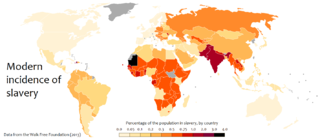
Debt bondage in India or Bandhua Mazdoori was legally abolished in 1976 but remains prevalent due to weak enforcement by the government. Bonded labour is a system in which lenders force their borrowers to repay loans through labor. Additionally, these debts often take a large amount of time to pay off and are unreasonably high, propagating a cycle of generational inequality. This is due to the typically high interest rates on the loans given out by employers. Although debt bondage is considered to be a voluntary form of labor, people are forced into this system by social situations.

Slavery in international law is governed by a number of treaties, conventions and declarations. Foremost among these is the Universal Declaration on Human Rights (1948) that states in Article 4: “no one should be held in slavery or servitude, slavery in all of its forms should be eliminated.”








